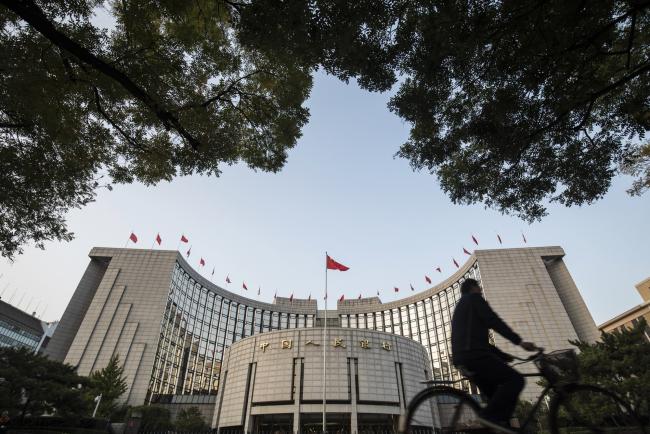 © Bloomberg. A man rides a bicycle past the People’s Bank of China headquarters in Beijing, China, on Monday, Oct. 23, 2017. China’s central bank is said to have gauged demand for 63-day reverse repurchase agreements for the first time ever. Photographer: Qilai Shen/Bloomberg
© Bloomberg. A man rides a bicycle past the People’s Bank of China headquarters in Beijing, China, on Monday, Oct. 23, 2017. China’s central bank is said to have gauged demand for 63-day reverse repurchase agreements for the first time ever. Photographer: Qilai Shen/Bloomberg(Bloomberg) — China took another step to ease the pressure from its deleveraging campaign, as authorities try to mitigate increasing risks to the economy from the trade war with the U.S.
The People’s Bank of China told some banks on Wednesday that a specific capital requirement will be eased to support lending, according to people familiar with the matter. The change is being made to support local financial institutions in meeting credit demand effectively, said the people, who asked not to be named because the instructions haven’t been made public.
Easing capital requirements is another move by policy makers in Beijing to shore up growth amid the escalating trade war with the U.S. While China is trying to cut leverage across its system and rein in risk, the threat posed by America’s actions has seen it scale back some of its previous efforts to slow the expansion of credit. The central bank specified that the capital-buffer reduction is a counter-cyclical adjustment in reaction to rising uncertainty over trade, the people said.
“This is an important gesture of easing and will boost broad credit growth,” said Ma Kunpeng, Shanghai-based chief financial analyst at Shenwan Hongyuan Group. “It’s hard to put a definitive number on the impact as banks are facing other constraints such as deposit growth, loan quota and so on.”
Banking shares gained in Shanghai and Hong Kong trading, with Bank of Ningbo Co. up 2.4 percent and Bank of Shanghai up 1.7 percent as of 9:36 a.m. The benchmark gained 0.2 percent.
Policy makers have been busy rolling out initiatives to aid growth amid fears that the trade war, coinciding with the efforts to cut leverage and shrink China’s shadow-banking industry, will stall the economy. The PBOC has cut reserve-requirement ratios three times this year, while tax cuts and infrastructure projects were announced on Monday. The changes are seen as an easing of policy rather than a U-turn by the government, analysts have said.
The PBOC said in the notice sent to some banks on Wednesday that the so-called “structural parameter” in the Macro-Prudential Assessment of balance sheets will be lowered by around 0.5 points, reducing required capital buffers, the people familiar with the matter said. The central bank didn’t immediately respond to request for comment.
China’s $10 trillion shadow-banking sector, seen by the government as a serious risk to economy stability, saw the biggest net monthly drop on record in June, according to Bloomberg calculations based on the central bank’s data. While the sector has been a target of the deleveraging effort, such a pullback has weighed on the supply of new credit to the real economy.
Investment Headwind
A major headwind facing the economy on the back of tighter credit would be the ensuing slump in private-sector investment, a pillar of the economy this year. Private companies have found it difficult to borrow anywhere, with shadow banking credit contracting, bond defaults rising to a record pace, smaller lenders downgraded and dollar debt repayment pressure mounting.
The PBOC’s reduction could “significantly relieve the regulatory pressure and encourage bank lending,” said Nie Wen, an economist at Huabao Trust Co. in Shanghai. He said that city commercial banks and joint-stock banks are the main funding source for small firms. More easing policies can be expected in the future if existing measures don’t yield the desired effects, Nie said.
While a formal change of direction on the anti-leverage campaign or an official shift to monetary easing could potentially come at meetings of the top political leadership, from the end of this month, officials are unlikely to abandon goals to cut debt or cut borrowing costs more broadly.
Fusion Media or anyone involved with Fusion Media will not accept any liability for loss or damage as a result of reliance on the information including data, quotes, charts and buy/sell signals contained within this website. Please be fully informed regarding the risks and costs associated with trading the financial markets, it is one of the riskiest investment forms possible.
Source: Investing.com



























